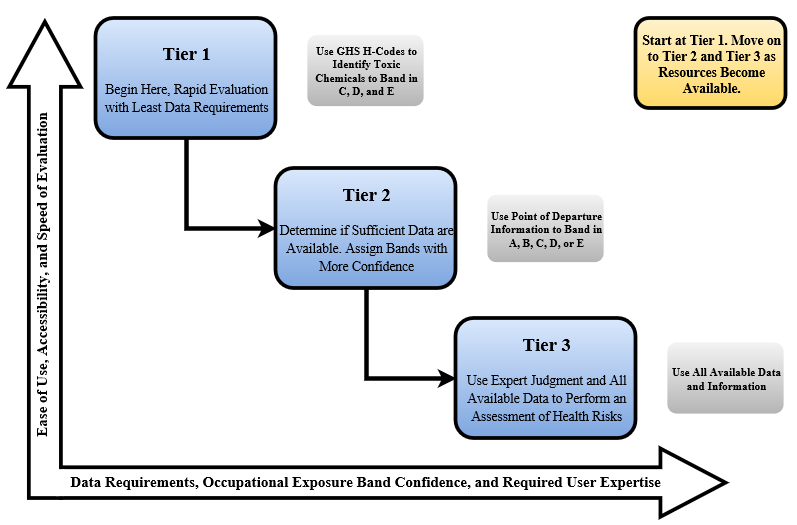OCCUPATIONAL EXPOSURE BANDING
Approach to Occupational Exposure Banding
The proposed NIOSH occupational exposure banding process utilizes a three-tiered approach (Figure 3) [ McKernan et al. 2016 ]. Each tier of the process has a different requirement for data sufficiency, which allows a variety of stakeholders to use the exposure banding process in many different situations. Selection of the most appropriate tier for a specific banding situation depends on the quantity and quality of the available data and the training and expertise of the user [ McKernan and Seaton 2014 ]. Tier 1 requires relatively little information and requires only modest specialized training of the user, and each of the successively higher tiers requires more chemical-specific data to successfully assign an OEB. A primary goal of Tier 1 is to give the user a quick summary of the most important health effects associated with exposure to the chemical of interest, and to quickly identify extremely toxic chemicals that should be considered for substitution or elimination. Tier 2 requires the user to examine a number of publicly available databases and extract relevant toxicological data to be used in a banding algorithm. Tier 3 employs expert judgment to critically evaluate experimental data and discern toxicological outcomes [ McKernan et al. 2016 ]. Users begin with the Tier 1 process as an initial screening, and move to Tier 2 to perform a more thorough evaluation of the chemical. Tier 3 is employed if a data sufficiency requirement for Tier 2 is not met and when expert judgement is available.

Figure 3: The proposed NIOSH occupational exposure banding process utilizes a three-tiered approach that involves increasing data requirements about the potency of a chemical and the severity of the health outcome from exposure to that chemical [McKernan et al. 2016].
Three Tiers
Tier 1
The proposed NIOSH Tier 1 occupational exposure banding process is aligned with the Globally Harmonized System of Classification and Labelling of Chemicals (GHS) [ UNECE 2013 ]. The user collects GHS hazard codes and categories from proposed NIOSH-recommended sources, and then determines the corresponding band for each of the hazard codes and categories using the NIOSH criteria. Of the endpoint bands, the band that represents the lowest range of exposure concentrations is selected as the OEB for the chemical. Users can complete this process to quickly identify highly toxic chemicals for which further banding should be considered [ McKernan et al. 2016].
Tier 2
The proposed Tier 2 process requires the user to search the proposed NIOSH-recommended sources for information related tonine standard health endpoints (see Health Effect Endpoints). Next, the user compares the extracted data, which can be either quantitative or qualitative, to the NIOSH Tier 2 criteria. Based on the NIOSH criteria, the user assigns the chemical to a band for each endpoint for which data exist. As with Tier 1, band that represents the lowest exposure concentration range is assigned as the OEB for the chemical (provided the available data meet minimum requirements). This process is more time-intensive than Tier 1 but produces a band that is based on more reliable data[ McKernan et al. 2016].
Tier 3
The proposed Tier 3 process is designed with the recognition of the fact that not all chemicals can be banded in Tier 1 or Tier 2 because of potential lack of available data from the NIOSH-recommended sources . Therefore, Tier 3 requires a detailed survey of the relevant primary literature and an analysis of resulting experimental data. The Tier 3 process relies on expert judgement and a critical evaluation of the available dose-response data [ McKernan et al. 2016 ].
Health effect endpoints
For Tier 1 each of the health endpoints defied by GHS are considered separately, while in Tier 2, respiratory and skin sensitization are further considered separately. The user collects data related to each health endpoint, compares the data to the NIOSH criteria, and assigns an endpoint-specific band for each endpoint. The final OEB assigned to the chemical is the most health protective of endpoint-specific bands. Toxicological health endpoints include:
- Carcinogenicity
- Reproductive toxicity and developmental effects
- Specific target organ toxicity from repeated exposure
- Genotoxicity
- Respiratory and skin sensitization (considered separately in Tier 2)
- Acute toxicity
- Skin irritation and corrosion, and
- Eye irritation and corrosion.
These endpoints can be measured qualitatively (categorically), quantitatively (potency or dose-response relationships), or both. The process allows the user to examine multiple toxicological health endpoints.
Limitations
Although occupational exposure banding holds a great deal of promise for the occupational hygiene profession, there are potential limitations. As with any analysis, the outcome of the NIOSH occupational exposure banding process – the OEB – is dependent upon the quantity and the quality of data used and the expertise of the individual using the process [ McKernan and Seaton 2014]. In order to maximize data quality, NIOSH has compiled a list of NIOSH-recommended sources which can provide data that can be used for banding. Furthermore, for some chemicals the amount of quality data may not be sufficient to derive an OEB. In such cases,deriving an OEB is not possible. It is important to note that the lack of data does not indicate that the chemical is safe. Other risk management strategies, such as control banding, can then be applied.
- Page last reviewed: March 15, 2017
- Page last updated: March 15, 2017
- Content source:
- National Institute for Occupational Safety and Health Education and Information Division


 ShareCompartir
ShareCompartir